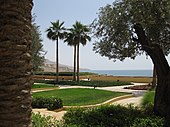
Jordan is divided into twelve historical regions, further subdivided into districts (liwa), and often into sub-districts (qada).

Madaba is the capital city of Madaba Governorate in central Jordan, with a population of about 60,000. It is best known for its Byzantine and Umayyad mosaics, especially a large Byzantine-era mosaic map of the Holy Land. Madaba is located 30 kilometres south-west of the capital Amman.

Balqa' is one of the governorates of Jordan. It is located northwest of Amman, Jordan's capital.

Dhiban, known to the Moabites as Dibon, is a Jordanian town located in Madaba Governorate, approximately 70 kilometres south of Amman and east of the Dead Sea. Previously nomadic, the modern community settled the town in the 1950s. Dhiban's current population is about 15,000, with many working in the army, government agencies, or in seasonal agricultural production. A number of young people study in nearby universities in Karak, Madaba, and Amman. Most inhabitants practice Islam.

Tafilah is one of the governorates of Jordan, located about 180 km south-west of Amman, Jordan's capital.

Zarqa Governorate is the third largest governorate in Jordan by population. The capital of Zarqa governorate is Zarqa City, which is the largest city in the governorate. It is located 25 kilometres (16 mi) east of the Jordanian capital Amman. The second largest city in the governorate is Russeifa.

Ma'an is one of the governorates of Jordan, it is located south of Amman, Jordan's capital. Its capital is the city of Ma'an. This governorate is the largest in the kingdom of Jordan by area.

Amman Governorate, officially known as Muhafazat al-Asima, is one of the governorates in Jordan. The governorate's capital is the city of Amman, which is also the country's capital. The administrative center of the governorate as well as all government offices and parliament are located in the Abdali district.

Irbid or Irbed is a governorate in Jordan, located north of Amman, the country's capital. The capital of the governorate is the city of Irbid. The governorate has the second largest population in Jordan after Amman Governorate, and the highest population density in the country.

Jerash Governorate is one of 12 governorates in Jordan. It is located in the northwestern side of the country. The capital of the governorate is the city of Jerash.

Karak is one of the governorates of Jordan, located south-west of Amman, Jordan's capital. Its capital is Al-Karak. It s bordered by Madaba and the Capital governorates to the north, Ma'an Governorate to the east, Tafilah Governorate to the south, and the Dead Sea to the west.

The district "Liwaa" are the administrative centres in Jordan. The twelve governorates of Jordan contain fifty-two alwiya which are listed below by governorate. In many cases the name of the chief town is the same as the name of the district (liwa) or sub-district (qadaa) administered.

Jordan is a sovereign Arab state in the Middle East. The capital, Amman, is Jordan's most populous city as well as the country's economic, political and cultural centre.

Early Byzantine mosaics in the Middle East are a group of Christian mosaics created between the 4th and the 8th centuries in ancient Syria, Palestine and Egypt when the area belonged to the Byzantine Empire. The eastern provinces of the Eastern Roman Empire and its continuation, the Byzantine Empire, inherited a strong artistic tradition from pagan Late Antiquity. The tradition of making mosaics was carried on in the Umayyad era until the end of the 8th century. The great majority of these works of art were later destroyed but archeological excavations unearthed many surviving examples.

Ajloun Governorate is one of the governorates of Jordan, located north of Amman the capital of Jordan. Ajloun Governorate has the fourth highest population density in Jordan with a population density of 350.1 people/km2. It is bordered by Jerash Governorate from the south east and Irbid Governorate from the north and west.

Khirbet al-Mukhayyat, also commonly known as the town of Nebo, is a village in Madaba Governorate in Jordan. The village is about 3.5 km from Mount Nebo, also known as Siyagha. Many Byzantine churches were found in the village, including the Church of Saint Lot and Saint Procopius, the church of St. George, and the al-Kaniseh Monastery located a short distance down in a valley below the hill. The town also contains material culture from a wide range of phases from the Chalcolithic to the Ottoman period including several Hellenistic features, an Iron Age fort, and a number of caves, tombs, cisterns and agricultural infrastructure.

The Balqa, known colloquially as the Balga, is a geographic region in central Jordan generally defined as the highlands east of the Jordan Valley in between the Zarqa River to the north and the Wadi Mujib gorge to the south.

Michele Piccirillo (1944–2008) was a Franciscan priest and expert in Byzantine archaeology. He is credited with advancing the study of early Byzantine archaeology, and especially the study of mosaics, in Jordan, Palestine and Syria.

The Umm ar-Rasas mosaics are a number of Byzantine mosaics discovered by Michele Piccirillo in the ruins of the Church of St. Stephen in Umm ar-Rasas, Jordan, in 1986.




























